A malfunctioning chemical effluents treatment plant and indolent pollution control body are silent as water-air contamination in MIDC Taloja threatens life and livelihood around and as far as Navi Mumbai
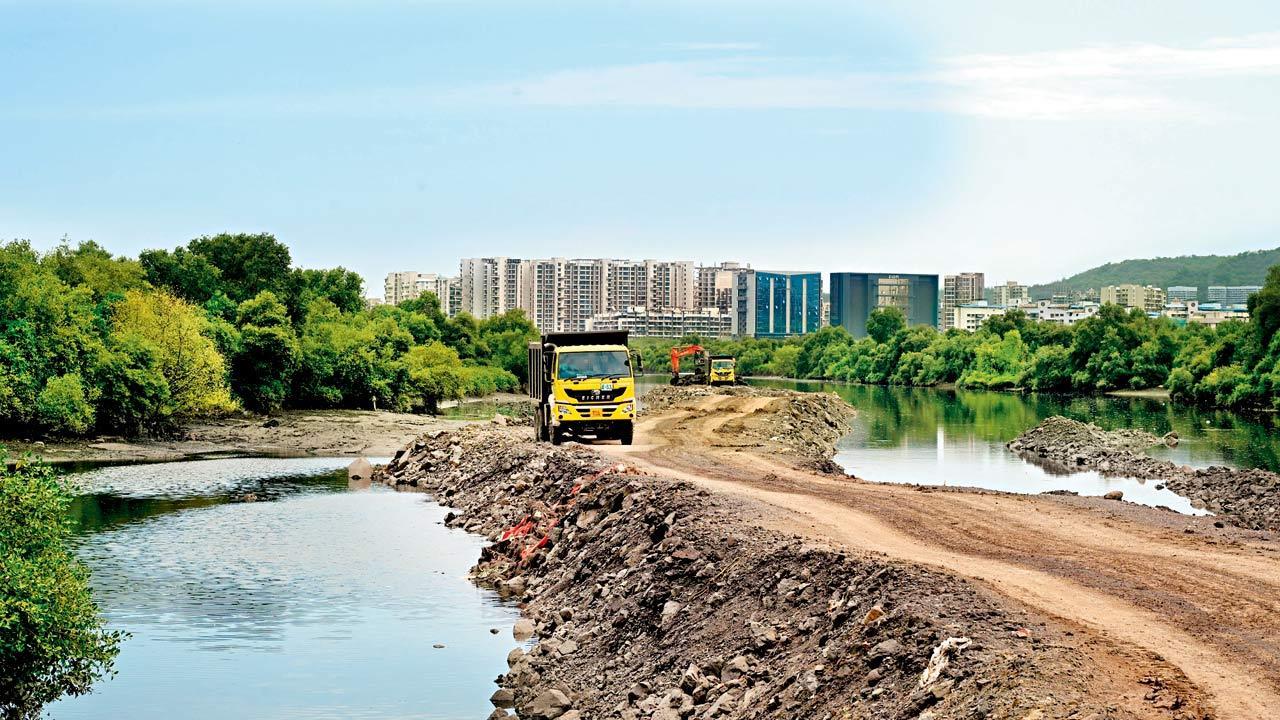
Environmental activists say private housing projects coming up around Taloja and Navade in a heavily polluted industrial zone spells trouble. The Kasadi and Ghot rivers, the former a water source for thousands of villagers, are choked with illegal effluents dumped by chemical firms, fisheries and paint manufacturers. Pics/Ashish Raje
Sixty-year-old Bhimabai Patil’s first inhale every morning is a lungful of foul-smelling industrial smog. Not just her; every breath of the residents of Siddhi Karavale village, and 26 others within a 400-meter radius of MIDC Taloja industrial area, is of toxic, chemical-laden air. A mere decade-and-half ago, stalls peddling watermelons lined the road to the village-turning-into-a-town. Taloja’s farmers grew the fruit, and the motorway had a biryani pit-stop said to be favoured by Meena Kumari.
ADVERTISEMENT
“I got married and moved here in 1981,” Patil says, “Air and water were cleaner then, even with industries nearby. But since 2002, we have been waking up to a strong, pungent smell that persists throughout the day and intensifies early in the morning and late at night.”
Patil says there’s hardly any villager who doesn’t complain about breathlessness. “Prolonged coughing has become very common,” she says, showing us a handful of pills from the local doctor to address her difficulty in breathing. “We’ve protested numerous times, but the police, public representatives, and even some villagers are in cahoots with these companies.”
 Madhu Verma, student, Parshuram Joma Mhatre School & Atmaram Dhondu Mhatre Junior College, Navade
Madhu Verma, student, Parshuram Joma Mhatre School & Atmaram Dhondu Mhatre Junior College, Navade
Sanjay Joshi, who lives in Waklan 4 km away, is a co-sufferer.
“Despite being in another district [from Taloja],” he says, “we cannot open our windows in winter. Instead of relocating those affected or enforcing stricter pollution norms, the authorities are bringing in more residents and exposing them to this polluted environment.”
Joshi is referring to the housing projects that coming up around Taloja and Navade, some by CIDCO (City and Industrial Development Corporation of Maharashtra) and others by private builders. Under its affordable mass housing scheme, the city-planning agency is offering 5,730 tenements in the area; 1,524 are reserved for the Economically Weaker Section (EWS) under the government’s free housing scheme.
 Workers atop the mountain of garbage at CIDCO’s landfill in Ghotawade. Residents claim that the black sludge from the decaying garbage heaps at has been poisoning their crops and livestock by seeping into the soil and groundwater, especially during the monsoon
Workers atop the mountain of garbage at CIDCO’s landfill in Ghotawade. Residents claim that the black sludge from the decaying garbage heaps at has been poisoning their crops and livestock by seeping into the soil and groundwater, especially during the monsoon
“It is wrong on part of city planners to develop townships near heavily polluting industrial zones,” BN Kumar, director, NatConnect Foundation, tells Sunday mid-day. “The historic blunder made while developing Vashi node is being repeated in Taloja. We are shamelessly pushing people into concrete jungles without caring for either the environment or people’s health.”
Vashi is sandwiched between the chemical industrial belt of Thane-Belapur and Chembur; the wind blows in pollution from both regions. Kumar says on some days, he can smell the stench of garbage in Govandi’s landfill.
Located in Raigad district, and now an extension of Kharghar, MIDC Taloja was originally envisioned as a significant industrial area. It quickly gained prominence due to its strategic location between Greater Mumbai and Panvel. It has now earned a new moniker: The Pollution Hub of India.
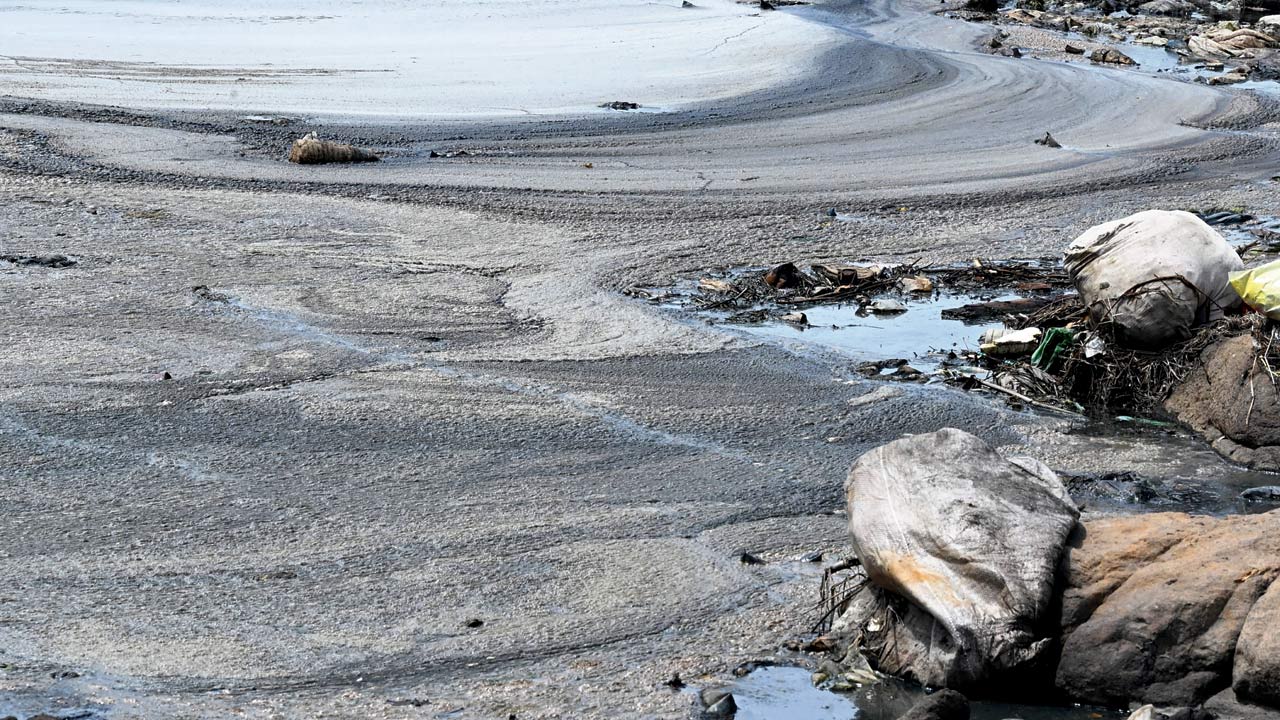 The 20-km-long Kasadi river is the source of water for nearly 11,000 villagers, and their livestock. A local environmentalist says the river is now full of polluted water, which is a combination of chemicals, including chloride
The 20-km-long Kasadi river is the source of water for nearly 11,000 villagers, and their livestock. A local environmentalist says the river is now full of polluted water, which is a combination of chemicals, including chloride
Taloja hosts a plethora of industries including those that manufacture chemicals, dyes, pharmaceuticals. It also hosts fertiliser firms, paint manufacturers, breweries, fisheries and units of seafood exporters and textile units, all provided by the government with necessary infra, power and water supply to make it a vital industrial hub.
As of 2024, Taloja has 975 functional industries located 400 metres or less away from residential villages. Often, hazardous and contentious projects are either sent to Taloja or utilise its facilities as temporary measures until permanent alternatives are found.
Sadguru Wamanbaba Maharaj Sangharsh Samiti, a community group formed by the residents, has been fighting since 2017 for the closure of the dumping yard at Chal village, on the charges that black water released by the decaying waste seeps into the earth, contaminating the ground water table, killing crop as well as livestock.
 Infected leaves of the karanj tree at Siddhi Karavale village. Pics/Ashish Raje
Infected leaves of the karanj tree at Siddhi Karavale village. Pics/Ashish Raje
Two garbage treatment and dumping plants—one run by CIDCO and the other by Mumbai Waste Management Limited—are located 2 and 2.3 km away respectively. The Mumbai Waste Treatment Limited covers about 100 acres within MIDC Taloja and treat 60,000 metric tonnes of garbage annually, and incinerate 30,000 metric tonnes a year. The CIDCO landfill takes in 730 tonnes of urban waste every day, including over 500 tonnes from areas under the Panvel Municipal Corporation (PMC).
Aadesh and Pradeep Patil, farmers from Siddhi Karavale, claim that black sludge has been destroying their paddy yield in the last 15 years.
“The quality and quantity of fruits on our trees has drastically declined,” says Pradeep. “Every monsoon,” adds Aadesh, “a foul smell emanates from the accumulated and overflowing rainwater.”
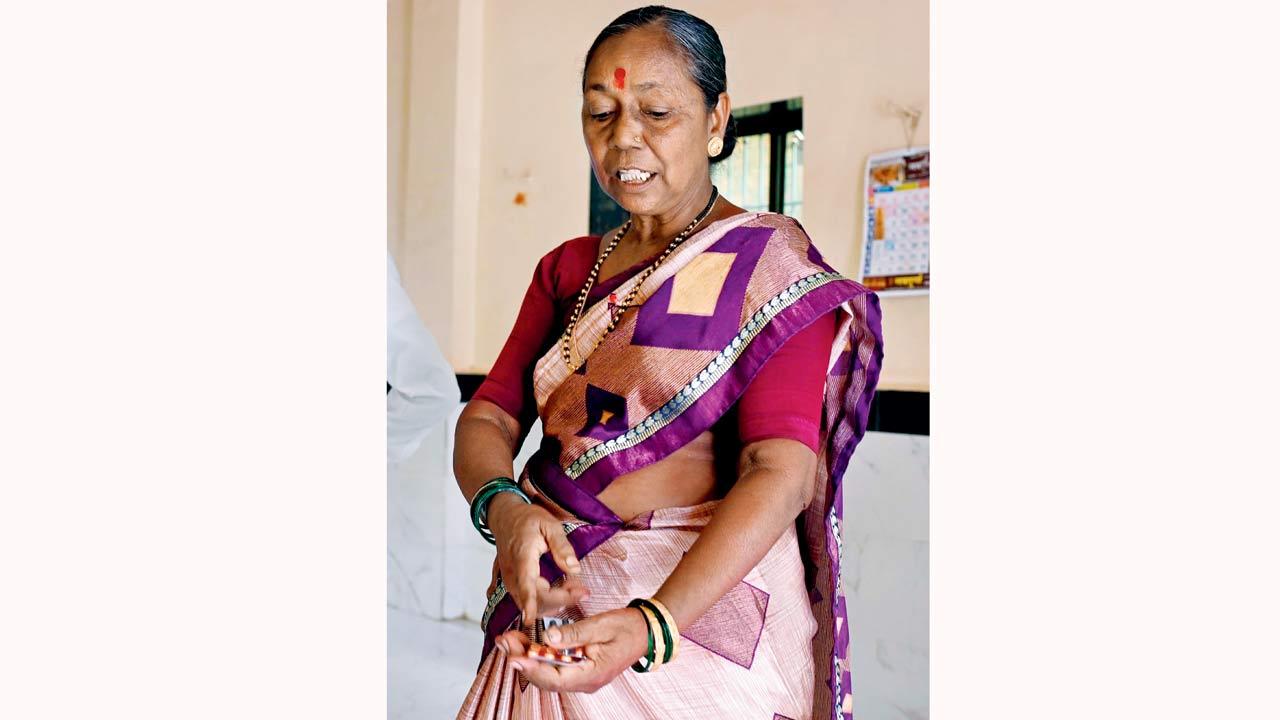 Bhimabai Patil, resident
Bhimabai Patil, resident
Shreeyash Mhatre says that he suffered commercial loss last year when 14 goats belonging to him died in August. After grazing in Navade village around an area where possibly contaminated water had collected, Mhatre said they died. He buys young doelings and bucklings at Rs 8,000-Rs 10,000 and raises them for later sale. “I had a total of 27 goats. Seven of these, I sold for between Rs 22,000 and Rs 25,000 each. Of the remaining, 14 died. This is my only business.”
In June 2023, Mahindra Mhatre says he lost buffaloes to contamination in the Kasadi river. “I suffered a loss of about Rs 2.5 lakh. The river swells and widens during the rains and branches into rivulets,” says Shreeyash. “We have lived in Navade for generations, but never have we experienced this. We dread the monsoons now.”
The 20-km-long Kasadi river provides water to nearly 11,000 residents of villages it criss-crosses, and nourishes the groundwater. It’s close to the MIDC Taloja industrial zone, and the lifeline for villages such as Devichapada, Dongrichapada, Brahmanpada, Pendhar, Padgha, Navade, Siddhi Karavale, Ghot, Kudupada, Kanpoli. Tonadre, Nagzari, Usatane, Taloja, Taloje Majkur, Roadpalli, Pale, Kolwadi, Fanaswadi; not to mention adivasi padas in the area.
A local environmentalist says the toxic sludge coating the riverbed is a combination of chemicals, including chloride which in quantities above 200mg/l can prove toxic to vegetation and animal life. Local authorities are said to warn worshippers from going into the river from Ganesh ghat for rituals.
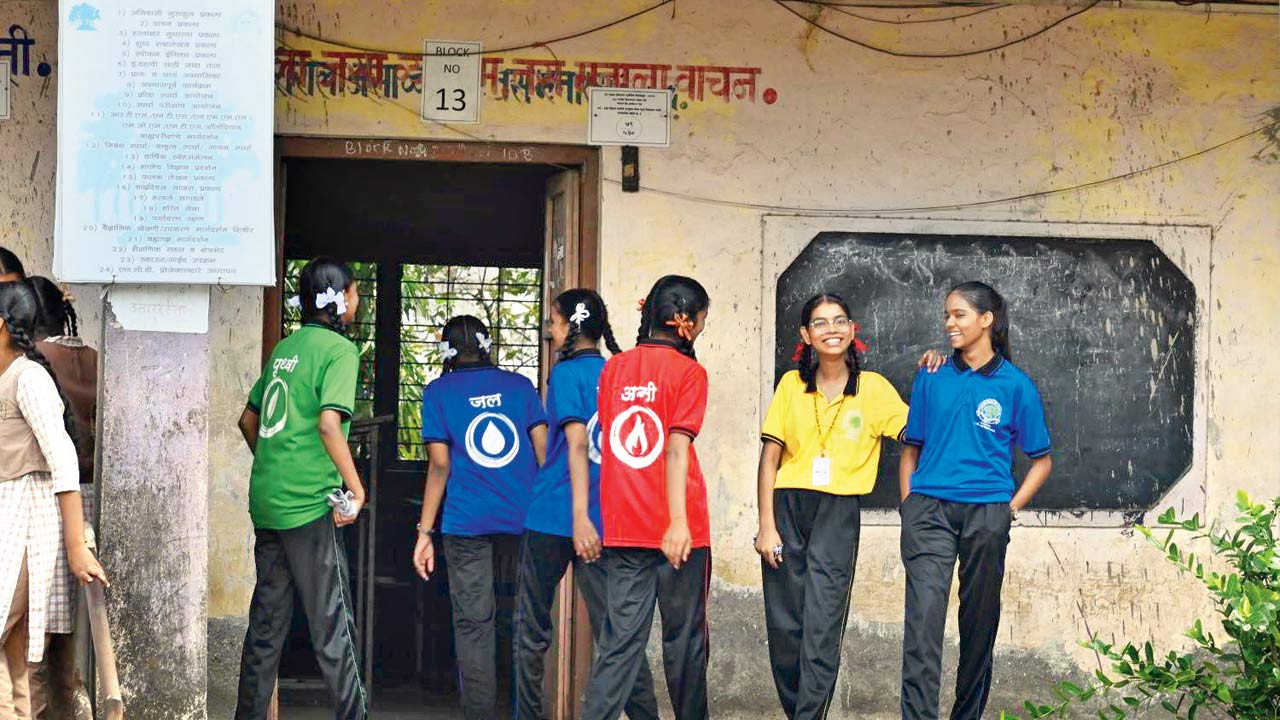 Students of Parshuram Jhoma Mhatre Vidyalaya and Atmaram Dhondu Mhatre Junior college in Navade say they wear masks to school and can’t concentrate in class because their eyes burn
Students of Parshuram Jhoma Mhatre Vidyalaya and Atmaram Dhondu Mhatre Junior college in Navade say they wear masks to school and can’t concentrate in class because their eyes burn
In a research conducted in 2011 by Dr Rama Lokhande of Jaipur University, Dr Pravin Shingare from NM Institute of Science, Deepali Pimpale of Ghatkopar’s RJ College, it was stated, “The study was performed to investigate the concentration of toxic heavy metals like chromium (Cr), cadmium (Cd), nickel (Ni), zinc (Zn), copper (Cu), lead (Pb) and iron (Fe) in river. It was observed that the concentration of most of these heavy metals was much higher than the maximum permissible limits.”
The number of industries has grown from 600 to 975 since.
Arvind Mhatre, former corporator of the Panvel Municipal Corporation, has been petitioning the National Green Tribunal (NGT) since 2017. The NGT is a statutory body that deals with expeditious disposal of cases related to environmental protection and other natural resources.
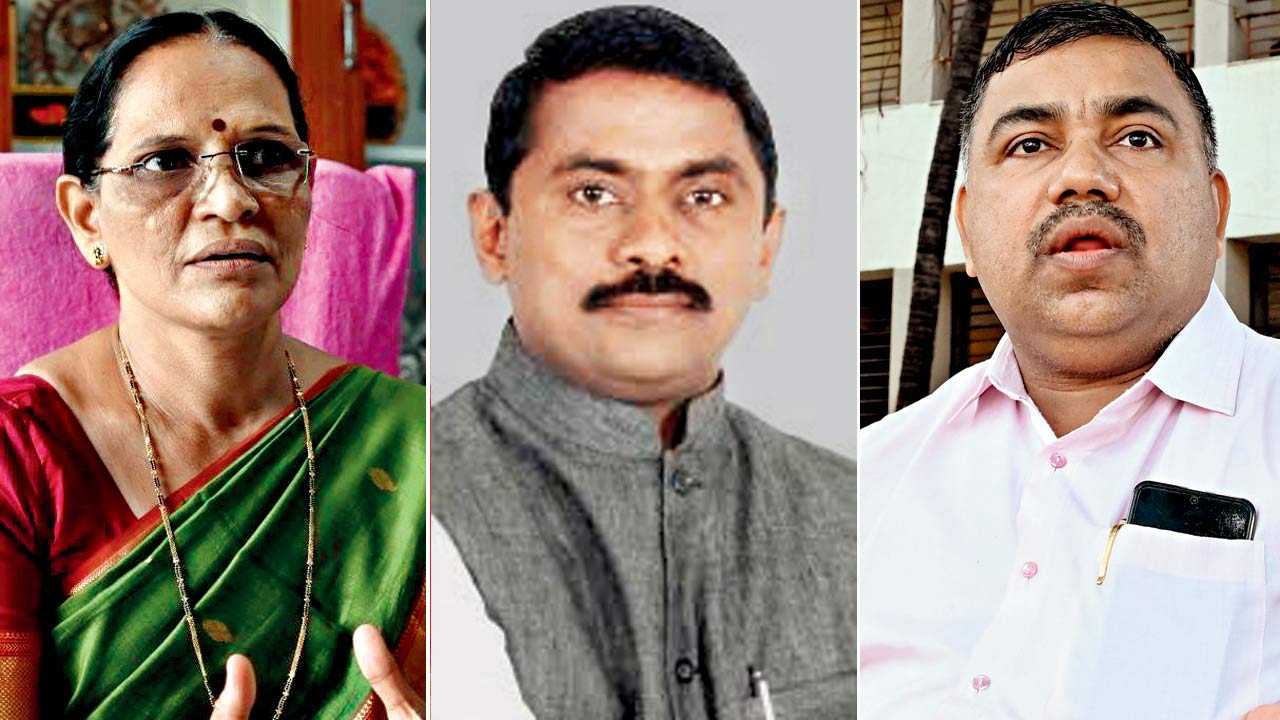 Vishaka Mohite; Prashant Thakur and Arvind Mhatre
Vishaka Mohite; Prashant Thakur and Arvind Mhatre
Mhatre claims evidence: the fur of dogs that drink from the Kasadi river has turned blue on some occasions, birds have been found dead, and there are instances of floating dead aquatic life. Despite IIT-Bombay’s report on river restoration dated 2023, no action has been taken by the MPCB, he claims. The institute had recommended several measures to improve river health, including the construction of sewerage and storm water drainage systems, diversion channels, directing industries along the river to treat their effluents, and enhancing co-ordination between agencies to prevent waste discharge into the river.
“The authorities are treating the area like a dumping ground by bringing in discarded and dangerous projects from other parts of the country,” Mhatre alleges.
He cites the example of bio-waste from a company in Deonar being directed to Taloja. In 2010, 2020 and 2021, MPCB directed Govandi-based SMS Envoclean, Mumbai’s sole bio-medical waste collection and management plant to send 50 per cent of its load to Taloja for treatment. The MPCB authorities said they are in talks with MIDC Taloja, and MIDC Patalganga-Borivali.
Also, the BMC has plans to set up a landfill here—since the ones in Mulund and Deonar have breached capacity. The Mulund dumping ground was shut in 2017 following the Bombay HC order 2016. Deonar continues to be in use. Mumbai’s MSW production is to the tune of 6,500 tons/day. It produces nearly 2,500 tons of construction and demolition waste/day.
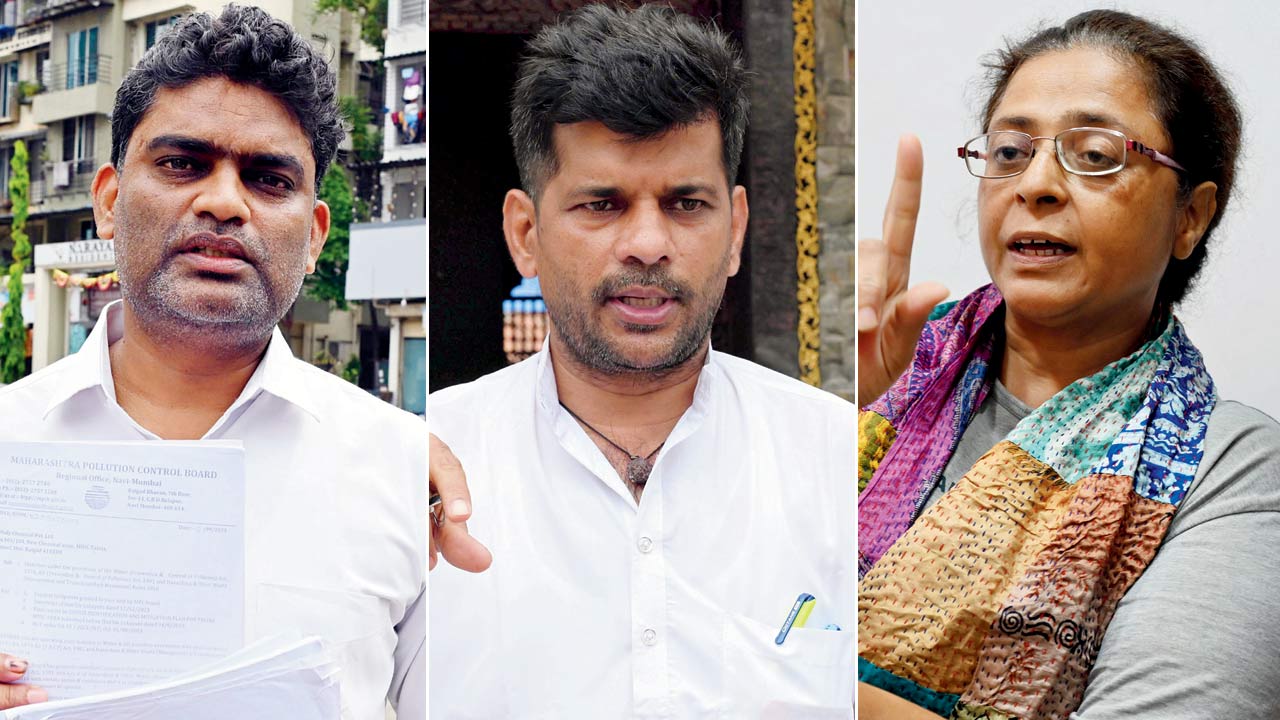 Ankush Gaikwad; Sanjay Joshi and Jyoti Nadkarni
Ankush Gaikwad; Sanjay Joshi and Jyoti Nadkarni
The BMC has acquired 29.71 hectares of land at Taloja from the state government, officials from BMC solid waste management department confirmed. Despite the urgent need for an alternative site to manage Mumbai’s waste, setting up the dumping ground at Taloja comes with challenges, like high transportation costs and protest by locals.
Mhatre has been pursuing the case of pollution of the Kasadi river and air pollution in Navade and adjoining areas for the last seven years. The authorities responsible [PCMC, CIDCO, MPCB] for regulating industrial processes in the MIDC Taloja Zone have failed significantly, he alleges.
Suresh Dharma Patil, a local Congress leader, alleges, “Although samples of water and soil are collected routinely, the result of the analysis is never shared with the villagers, nor is any action taken. Chemical companies, cold storages, and fisheries dispose of their waste into both Kasadi and Ghot rivers.”
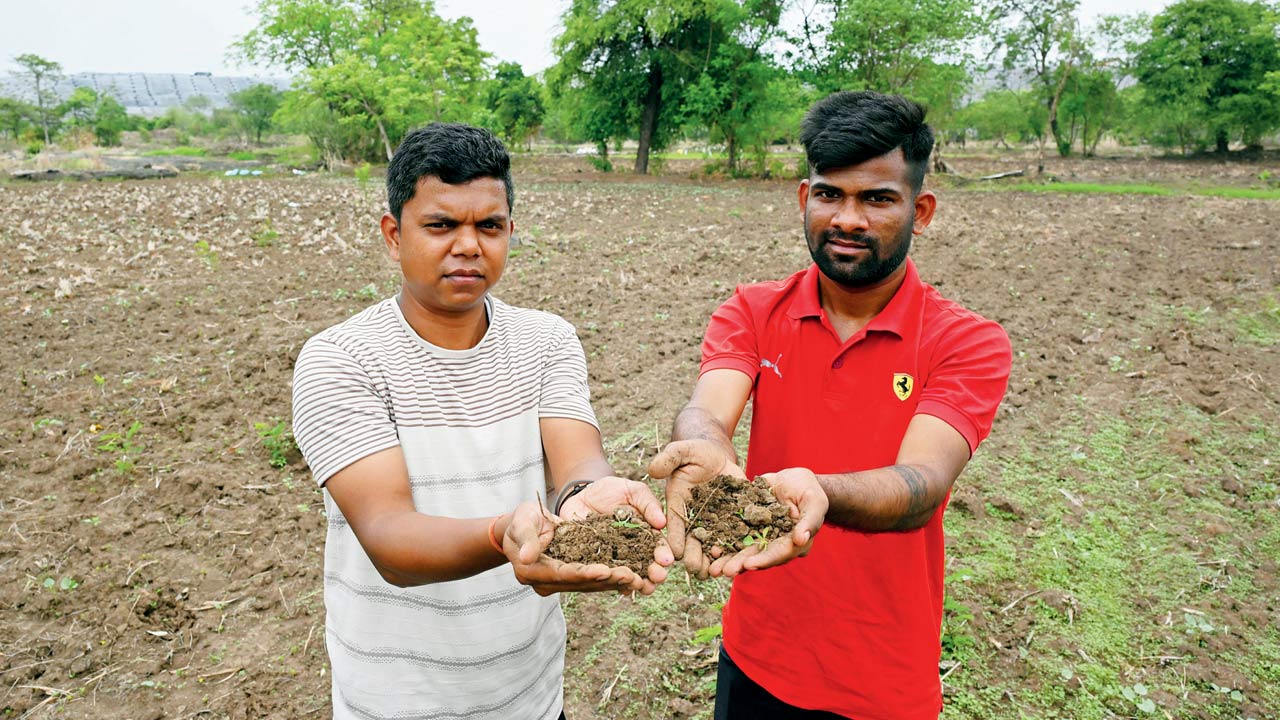 Aadesh and Pradeep Patil, farmers from Siddhi Karavale, claim that black sludge has led to their paddy yield sharply declining in the last 15 years
Aadesh and Pradeep Patil, farmers from Siddhi Karavale, claim that black sludge has led to their paddy yield sharply declining in the last 15 years
His solution is to monitor violations closely, or relocate villagers. “The odour of chemicals and fish waste permeates through air-conditioners too. Safety must be prioritised; there was even a blast at a private waste management company [In October 2018, a JCB operator was injured when moving a chemical drum]. Buffer zone norms are being violated.” According to experts, a buffer between 50 metres for a mechanical, industrial unit to 3 km for a chemical unit, is advisable.
Prashant Thakur, BJP MLA from Panvel, criticised the MPCB for what he says is failure to monitor industrial activities and address violations in a timely manner. “Taloja, Panvel, Kalamboli, Kharghar, and adjoining areas, including Uran, are suffering from severe air pollution. Additionally, the contamination of water bodies due to industrial effluents has adversely affected human and animal life as well as the environment. The issue of dumping yards has also been highlighted by the local residents,” Thakur tells mid-day.
Thakur stresses that despite an NGT order to shut down polluting units, they continue to operate.
Temporary shut down is an eyewash, he argues.
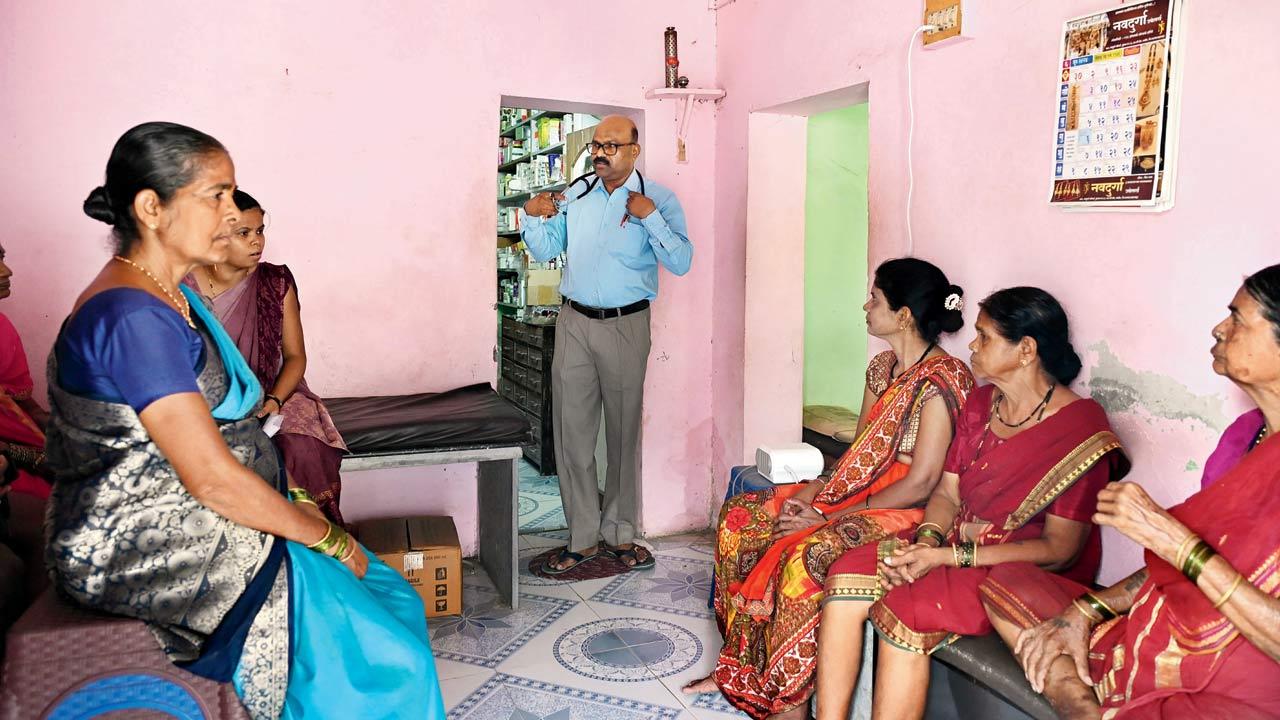 Dr Pratap Patil at his dispensary in Siddhi Karavale. “I do encounter patients with rashes on their hands and neck, likely caused by polluted water and exposure to harsh chemicals in the air,” he tells mid-day
Dr Pratap Patil at his dispensary in Siddhi Karavale. “I do encounter patients with rashes on their hands and neck, likely caused by polluted water and exposure to harsh chemicals in the air,” he tells mid-day
“During the last assembly session, environment was under minister Deepak Kesarkar. We invited him to witness the situation firsthand and intervene, but it unfortunately didn’t materialise, and then we had the LS elections. However, after the MLC elections, we plan to arrange a visit by the minister. The department is now under the chief minister himself. Seeing first-hand the suffering of the people will surely have significant impact and lead to results,” Thakur assures.
Ankush Gaikwad has been advocating environmental protection for three years. “We often conduct inspections of the region, including the Kasadi river, with officials from MPCB,” he says. “Recently, we raised the issue of a non-functioning CETP [Common Effluent Treatment Plant]. I appeal to the authorities to address the issue of chemicals and fertilizers being directly discharged into the river.” Locals say that MPCB has a vigilance squad that inspects industrial units at night when industries are suspected to remove the filters to speed up production.
In 2019, the MPCB said it shut four polluting factories after issuing them a warning and because they didn’t comply with the order.
When Mumbai’s AQI had hit worrying levels, in 2023, then BMC commissioner Iqbal Singh Chahal had at a press conference said that he had directed MIDC to check for polluting units in MIDC Taloja and temporarily shut them if needed.
The air is so dense with impending doom that it’s affecting attendance in schools in the Panvel-Taloja region. Students attending early morning classes regularly complain of nausea and burning eyes, and wear masks for bare minimum ease of respiration. The management of Parshuram Joma Mhatre School and Atmaram Dhondu Mhatre Junior College in Navade has urged MPCB to intervene. “We appeal to the authorities to help us and these children,” principal Vishakha Mohite beseeched. “We encourage attendance but cannot force them, considering their health and well-being,” says assistant teacher Jagruti Mhatre. “We frequently discuss solutions to rising pollution levels, and students actively participate.” But individual measures such as planting more trees and throwing waste in the garbage bin cannot turn back the Goliath of industrial level pollution.
To demonstrate the impact of pollution, science teacher Kavita Patil conducted an experiment last academic year. She collected soil samples from the banks of the Kasadi river and another from Dodhani village in Matheran. She then planted lady finger seeds in both. Those in the Dodhani soil sprouted within a week, while those in Kasadi soil showed no development. After adding organic compost to the Kasadi soil, the seeds germinated but the growth was slower, and the plants eventually rotted, Mhatre remembers.
“The stench is bad, but we manage; the breathlessness and burning makes it difficult to focus in class. Our teachers tell us to wash our faces with cold water, but that’s a temporary solution; they suffer too,” says Madhu Verma, a Class IX student.
Another student, Vedanti Khutarkar from Class X, says, “I wish the industries would move elsewhere. Our school is very good, and I don’t want to leave. I want to continue my education here till junior college.”
“I see cases of asthma attacks every four to five days,” says Dr Pratap Patil, a general physician at Siddhi Karavale. “I do encounter patients with rashes on their hands and neck, likely caused by polluted water and exposure to harsh chemicals in the air.”
A doctor who lives in Roadpali village, on the condition of anonymity, reported an increase in chronic obstructive pulmonary disease (COPD). “The air quality is dangerously poor,” he says, also pointing to carcinoma cases in Roadpali, Padgha and Vallabh, that he believes should be investigated.
Now that the distance between them has closed, Kharghar is not safe from Taloja’s effluents—international-level Central Park and golf course notwithstanding. Add to this the stone quarrying near Owe camp that residents have been fighting against, says Mangesh Ranawade, president of the Kharghar Taloja Colonies Welfare Association (KTC-WA). Residents of Sectors 34 and 35, on the edge of the MIDC Taloja region, believe they are most affected.
In 2020, NGO Waatavaran Foundation conducted a month-long survey and found that the air quality in locations along the Kharghar-Taloja-Panvel industrial corridor had poor air quality with PM (particulate matter) of 2.5, which can cause recurring respiratory problems. The average data of PM 2.5 levels across five areas at Panvel was found to be 1.7 times the Indian standard (60 μg/m3) and four times the WHO standard (25 μg/m3). The NGO’s founder-CEO, Bhagwan Kesbhat tells mid-day,
“My daughter used to study at a reputed school in Panvel. She suffered from burning eyes, and I decided to shift her to another school in Khaghar when my family moved home from Taloja Phase 1 to avoid the risks of pollution.”
“The residents of Roadpali, Kalamboli, Panvel, have been breathing polluted air belched by the industries in Taloja,” Ranawade says. “Initially, our AQI readings showed normal levels, but private agencies indicated higher pollution. We rely on real-time monitoring apps to measure exposure to toxic air. MPCB has dismissed these, citing errors. Ranawade admits though, that the stench in Kharghar air has decreased by 50 to 60 per cent since 2017. However, it intensifies during the monsoon.
The group has been fighting the chemical fog since 2017, increasingly involving pulmonologists, local GPs, and researchers in their campaigns. “Why not include someone like me, a person directly affected by pollution and who has studied the problem extensively, in the environment committee?” says Ranawade.
Jyoti Nadkarni, who lives in Kharghar Sector 35, says the destruction of the mangroves may have accelerated the problem. She monitors air quality regularly, writes complaint letters to MPCB and has called out the dumping of debris in mangroves. “Mangroves are carbon sinks. Dumping of debris in mangroves and wetlands can significantly degrade the air quality in Kharghar and Panvel.”
The process of collecting, transporting, treating, and disposing of effluents from industrial estates is undertaken by a common effluent treatment plant (CETP). CETP assists small and medium-sized companies that cannot afford individual treatment plants. There is only CETP at MIDC Taloja, which some claim, has been defunct for a while, which is why harmful effluents are directly reaching the river.
Satish Shetty, president, Taloja Industries Association (TIA), says that the CETP has been lying defunct for 70 months. And it’s a handful of violating units that are giving the industries there a bad name.
“Despite its capacity to treat 27.5 million litres per day (mld), currently, only 16.5 mld is being processed, all with a Chemical Oxygen Demand (CoD) below 250, as per the norms. However, some companies do not follow the norms, and release effluents with CoD above 250 into the river. We have raised this issue with the MPCB.”
MIDC took over the CETP in November 2018 for rehabilitation and upgradation, spending a hefty sum, but Shetty claims that it has not yielded desired results of 24/7 operations. “The CETP was supposed to be handed over to us in December 2024, but we can’t accept it in its current state. We [industrial units] pay Rs 1.3 crore every month to MIDC for the treatment of effluents. Out of 975 members of CETP Co-Op Society, MPCB has failed to act against the 15-20 non-compliant companies.
Ample automation is available to monitor pollution to estimate concentrations of major pollutants. According to norms, we must take back a sample for checking and verifying CoD before releasing effluents,” Shetty adds.
A senior MPCB official, who requested anonymity, tells this writer, “The issue in villages like Siddhi Karavale, surrounded by dumping yards and waste treatment plants, is distinct. These facilities do not operate scientifically, causing garbage to rot. During rains, if not covered, the water flows into farms and residential areas. CIDCO and PCMC need to address these violations.”
Regarding effluents in the Kasadi river, the official explains, “Effluents mix in storm water drains in the first rains, due to choked pipelines and road works. On June 4 and 5, we had directed MIDC to clean and repair the pipelines, before the monsoons. They are doing it now and significant progress has been made, but the pipelines are extensive and the work requires time. Cleaning and maintaining these large pipelines before the monsoon is crucial.”
The MCPB official also suggested that CIDCO and PCMC monitor the permitting of residences near MIDC. “MIDCs used to be situated outside residential zones, minimizing health risks from industrial violations. We monitor compliance and act against violators, but we can’t take responsibility for the increasing population around MIDC. When the new residents face ventilation issues, exposure to pollution and stench, all fingers [unfortunately] point to MPCB.”
Deepak Bobade Patil, deputy engineer, MIDC Taloja, tells mid-day that all their pipelines are new and work was completed in 2021.
“These are robust pipelines, not easily damaged. We regularly clean blockages and instruct industries to treat effluents before releasing them into the CETP, but this [instruction] is not always followed. We have warned the industries and even informed the MPCB. The MPCB should take action.” Contrary to Shetty’s claim, Bobade Patil says that the CETP is operating fine.
Regarding industries releasing effluents into surrounding water bodies, Bobade Patil tells mid-day, “We [MIDC] provides space to various companies, including those in chemical, petrochemical, pharmaceutical, and food processing businesses.
It’s the MPCB’s responsibility to monitor whether these companies are following environment norms and ensure they do not release untreated effluents directly into the river. We haven’t received such reports recently [of violations]. Individual companies might resort to it, and it’s MPCB’s job to monitor compliance and take action.”
730 tonnes
Waste ingested by CIDCO landfill every day
975
No. of functional industries in Taloja MIDC
 Subscribe today by clicking the link and stay updated with the latest news!" Click here!
Subscribe today by clicking the link and stay updated with the latest news!" Click here!







